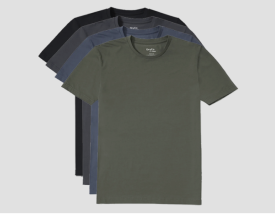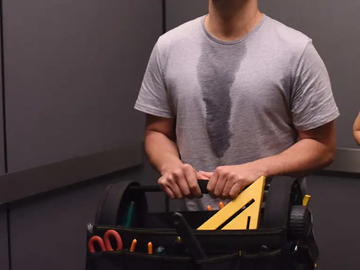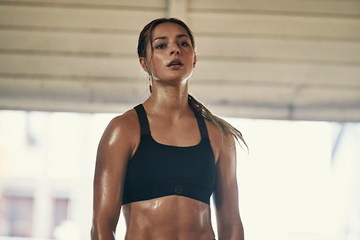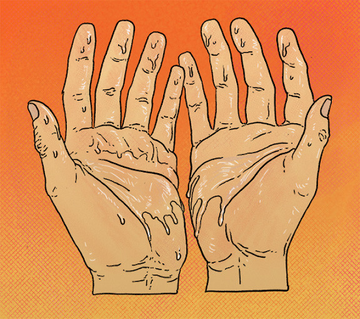Your skin and sweat share a complicated relationship. Sweat keeps your skin moisturized, even reducing the signs of aging. More importantly, sweat kills harmful skin bacteria.
But too much sweat it's a problem. Hyperhidrosis can damage the texture of your skin, making it uncomfortable to touch and prone to skin disorders. In fact, these complications can lead to infections that require medical treatment.
This post will take a look at the skin problems that arise from excessive sweating and how you can treat or prevent them.
Excessive Sweating May Lead to Maceration
Where its rhyming cousin “laceration” involves cuts of the skin, maceration refers to the wet, mushy appearance of skin that’s perpetually moist. It normally occurs when sweat enters a wound, along with pus and other fluids.
Most people have experienced maceration to some degree. A perfect example of this is when you soak in a bath or stay in a chlorinated pool for a long time, and your hands feel and look mushy. However, the maceration disappears soon after you dry off.
Macerated skin that stems from hyperhidrosis, though, looks light in color and is wrinkly, even soggy. It’s generally mild but it can get severe enough to cause pain and discomfort. Severe maceration makes your skin slow to heal when it's wounded, making it prone to infections. This creates a vicious cycle where maceration gets worse.
Excessive Sweating May Cause Jock Itch
If you think this condition is limited to high school or college athletes who don't wash their gear, think again. “Jock Itch”, known medically as tinea cruris, is a fungal condition that can affect anyone under the right circumstances. Hyperhidrosis sufferers can be more prone to jock itch if they sweat heavily in the groin or if sweat drips into the groin region.
The warmth of tight-fitted clothing and moisture from excessive sweating creates the perfect environment for the fungus to thrive. With that said, the Jock Itch fungus has to get there first - it’s usually spread sharing contaminated items of clothing such as towels.
The symptoms of this condition hardly need an introduction since the name speaks for itself. However, there are some additional symptoms including redness, flakiness, and peeling of the skin in the groin region. These symptoms can also extend into the thighs and buttocks.
Excessive Sweating May Lead to Athlete’s Foot
Jock Itch has an equally troublesome counterpart that once again, doesn't only strike athletes despite its name - “Athletes Foot”. Known medically as tinea pedis, this condition is also caused by a fungus that thrives in moist conditions, namely, a sweaty foot. Excessive sweating of the foot (plantar hyperhidrosis) creates the perfect environment for the fungus to take residence.
It is somewhat contagious, but you’re more likely to pick it up from infected skin particles found on clothing items, floor surfaces, or in shoes.
Athlete's Foot definitely makes you aware of its presence. Symptoms include an unshakable itch, along with a scaly red rash, small red blisters, and dryness that creeps up from the bottom of your foot towards its sides. In severe cases, and we’re sorry to gross you out here, Athlete's Foot can produce ulcers or sores that ooze a foul-smelling liquid.
Excessive Sweating May Lead to Bacterial Infections
At the beginning of this article, we mentioned how sweating kills harmful skin bacteria. But it’s a double-edged sword. Hyperhidrosis can lead to bacterial infections that are serious and potentially life-threatening. This usually occurs in instances such as severe maceration where the skin has been punctured or wounded and then infiltrated with bacteria.
A common bacterial species that cause problems in these cases are the staphylococcus genus. The most dangerous members of this family are the Methicillin-Resistant Staphylococcus Aureus (MRSA) variants. These superbugs have made headlines recently due to their ability to resist common antibiotics and cause severe illness.
Fortunately, this is a rare complication. You can almost prevent it entirely by addressing excessive sweating and the precursors to infection (such as maceration) that would cause them in the first place.
Treating & Preventing Further Complications
Treating skin complications caused by excessive sweating is a two-fold process. First and foremost, you've got to reduce excessive sweating. Second, if you've developed a skin complication, you have to treat it with the appropriate solutions. Interestingly enough, a lot of sufferers find treating the secondary skin complication easier than sweating itself since hyperhidrosis often requires a lifestyle overhaul.
Treat the Skin Complication
If you’ve got an itch or your skin is peeling, then don't waste any time - address it first for the sake of your comfort and sanity. Typically, fungal infections will warrant a medicated antifungal cream which you will apply directly at the source of infection. For maceration, you might need to use a medicated cream that promotes a healthy skin texture and healing of skin tissue.
Address Your Excessive Sweating Directly
Ultimately, you need to address excessive sweating at the root. Doing so will prevent the vicious cycle of curing a complication only for it to come back again. It may take some trial-and-error, but you have many treatment options at your disposal. They include:
- Prescription antiperspirants, typically aluminum-based ones that block sweat
- Anticholinergic medications that reduce the overproduction of the neurotransmitter, acetylcholine, which has been implicated as a trigger for excessive sweating
- Botox injections that block nerve signals to the sweat glands, inhibiting the release of sweat
- Iontophoresis and ETS for more severe cases that don't respond to medications or injections
We also want to stress the use of moisture-wicking and sweat-resistant fabrics. Sweat-resistant clothing wicks away moisture to prevent skin from becoming too moist. That could have a direct preventative effect on complications such as maceration.
When the skin can stay relatively dry, the texture will return to normal. Also what's sweat-resistant fabrics, which reduce the amount of moisture on your skin, may facilitate a drier environment that’s more hostile to funguses. That means a lower risk of Jock Itch and Athlete's Foot. Also, moisture-wicking and sweat-resistant fabrics will keep you feeling dry and comfortable.
Sometimes, Drier Skin is Better
Your skin definitely needs a certain level of moisture to remain healthy. But when your skin is too moist, it begins to break down. If you suffer from hyperhidrosis, you need to stay as dry as possible!
Even if you aren't able to completely rid yourself of excess sweat, staying relatively dry will go a long way. With solutions such as sweat-resistant fabrics, your skin will gradually heal itself in the absence of excess moisture.








